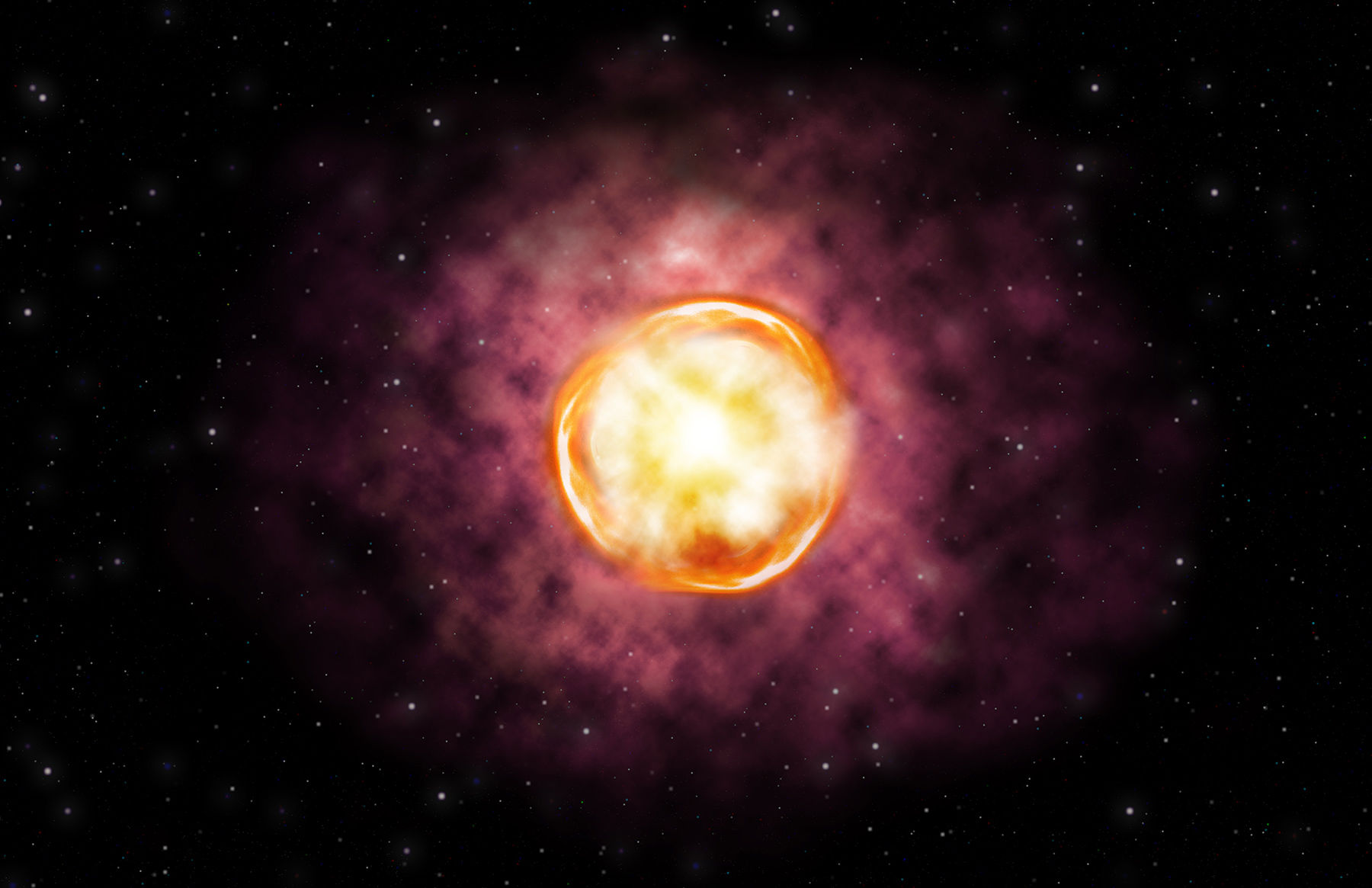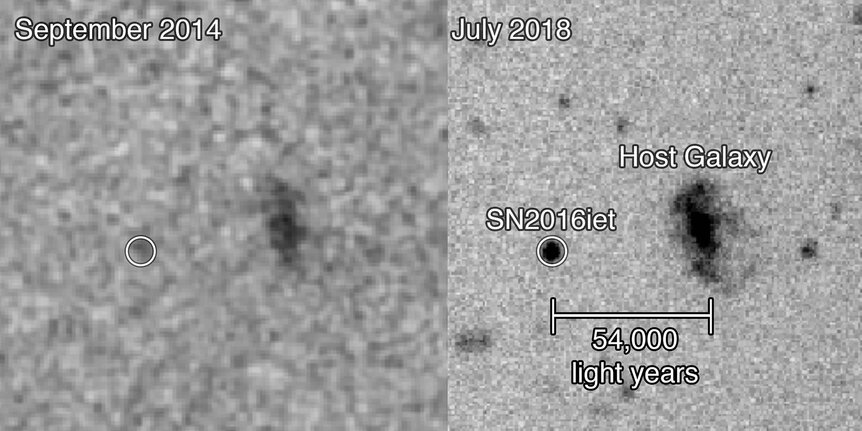Create a free profile to get unlimited access to exclusive videos, sweepstakes, and more!
Across the Universe, a star exploded so violently that it *completely* annihilated itself

A billion light years away, a monster star tore itself to shreds.
And by that I mean it tore itself to shreds. In general exploding stars — supernovae — leave behind a neutron star or black hole, but in this case it’s possible that the explosions was so over-the-top ridiculously violent that even the star’s core was ripped apart. It’s difficult to exaggerate how violent an event this was… but then, when huge amounts of antimatter are involved, that’s what happens.
Yes, seriously.
The event is called SN2016iet, a supernova that was detected on November 14, 2016. It was first spotted in data taken by the space-based Gaia observatory, and was followed-up by the Catalina Real-Time Transient Survey, then Pan-STARRS, and eventually the huge Gemini Telescope to get deep spectra of it. But it didn’t take long to determine that this particular supernova was weird.
And then they found it was really weird.
Most exploding stars get bright over the course of a few days, peak, then decay away over the next few months. SN2016iet didn’t do that: It peaked twice, which right away is bizarre. The second peak occurred about 100 days after the first, and both were phenomenally energetic, blasting out more than ten billion times the Sun’s energy for days at a time. Holy yikes.
But even then it didn’t behave properly. Instead of fading away into obscurity, the supernova continued to shine, fading much more slowly than usual. The astronomers were still able to observe it in spring of this year, more than two years after the initial explosion.
The more they observed it, the stranger it got. One of the strangest bits is its location: The explosion doesn’t seem to have happened inside a galaxy. The nearest obvious galaxy is an unnamed dwarf, only about 1/50th as luminous as our Milky Way (and about a billion light years away from Earth). But the supernova is at least 55,000 light years from the galaxy! That’s well outside the usual distance. Once the supernova faded enough, the astronomers detected the faint glow of hydrogen underneath the supernova’s own emission, meaning it’s either in a very faint satellite galaxy to the dwarf, or in a star cluster. If it’s in a galaxy it’s really dinky, and a cluster that far from the host galaxy is dang odd as well.
So what’s going on? Well, strap in. This is a doozy.
The team ran through a whole bunch of physical models trying to figure out what the heck SN2016iet is. Pretty much every normal supernova model failed in one way or another, and what they were left with is a demon.
When the progenitor star of SN2016iet was born, probably 3–4 million years ago, it was a true monster: It probably had a mass 120–260 times the Sun’s. That’s enormous. I mean, incredibly enormous. We don’t think there are any stars that massive in the Milky Way (though a few come close), and in fact we don’t think any can be.
Stars born in the recent Universe are contaminated with heavy elements like iron and magnesium, created when previous generations of massive stars exploded. Those elements are really good at absorbing the high-energy light inside stars, which heats them up. If a star gets really massive it generates a lot of energy, and if it can’t shed that energy it gets so hot it tears itself apart.
A star with more than about 150 times the Sun’s mass like that wouldn’t be able to exist… unless it doesn’t have those heavy elements in it, in which case they can shed the energy rapidly enough. Stars in the early Universe only had hydrogen and helium in them, so they may have been huge. The only way you can even get a star like that now is if it exists in an environment with very few heavy elements. Interestingly, the nearby galaxy (assumed to be the host to the star) is what we call a “metal-poor” galaxy, lacking those heavy elements, and therefore it’s possible it could make a star like this.
So. This extraordinarily massive star was born, and probably tore through its core hydrogen supply, converting it all to helium in just a few million years. Then it started fusing helium into carbon and oxygen, then finally carbon into neon. This is where its huge mass comes into play; I’ve explained this before in detail, but in a nutshell the neon fusion in an über-massive star like this proceeds at furious rates, and creates very high-energy gamma rays.
Usually these gamma rays help support the core against its own fierce gravity, but in this case the energies are so high that the gamma rays can convert into matter. This is called pair production, because each gamma ray makes two subatomic particles, one matter, one antimatter. This actually removes support in the core! It was relying on those gamma rays to keep it inflated, like a balloon full of hot air. Remove them, and the core collapses.
If the core has enough mass, the collapse generates a vast amount of energy as the fusion rate goes through the roof. The energy released is enough to tear the core apart, and that energy then rips through outer layers of the star. KABOOM. This is called a pair instability supernova. If the core still has lots of mass but not quite that much, you get a series of energetic pulses which then die off, until finally the core can’t contain them anymore and it explodes anyway. This is called a pulsational pair instability supernova.
The core masses you need for this are ridiculous… but the observations of SN2016iet indicate that when the core of the star exploded it had 55–120 times the Sun’s mass. Ye-freaking-GADS. That puts it somewhere in the range of these two kinds of explosion mechanisms, and this is the first time a supernova has been seen unambiguously to have exploded this way.
Still, that’s less mass than the star started with in total. It turns out the huge luminosity of the star even before it exploded means it shed vast amounts of mass in a super-solar wind for a long time before the end. And this is where it gets really weird.
That second peak in brightness? That’s probably when the supernova material screaming outwards at several thousand kilometers per second crashed into the material previously shed by the star. That caused a vast increase in brightness, getting up to about half as bright as the initial peak. The amount of that material out there was probably about 35 or so times the mass of the Sun. But the weird part is its location: It was pretty close to the exploded star, indicating it was ejected recently, and didn’t get far. In fact, it looks like it was all shed in the past decade before the explosion.
A decade. To lose 35 times the Sun’s mass worth of matter. To put this in some sort of scale that will still be nearly impossible to grasp, in the ten years before the ultimate explosion this star was blasting out matter equal to about Earth’s mass every thirty seconds. For a decade. Before it exploded.
It was pretty much at this point reading the journal paper that my brain wanted to leap out of my skull and run around in panicked circles screaming. I’ve run out of adjectives to describe an event like this.
A final weirdness is how long it’s taking the supernova to fade. Sometimes an extremely energetic neutron star called a magnetar is left by a pair instability explosion, and that pumps energy into the expanding debris, keeping it glowing for a long time. But in this case the amount of material in the core was far too large to make a neutron star. Also, in a normal pair instability event, the material in the outer layers is shed over many thousands of years, not in a single decade.
So in the end, nothing with this supernova fits. No one model seems to explain everything it’s doing, which means it truly is one of a kind. Nothing like it has ever been seen before, and we can’t fully explain its behavior.
I wonder though, just how long this will remain a unique event. We now observe thousands of supernovae every year. Even if this event is extremely rare, we’re likely to find another one eventually. Maybe not exactly like it, but close enough that we can compare them, see how they differ. That will help astronomers understand how these catastrophic events occur in the first place. Although these kinds of supernovae are at the tippy-top of the scale, they provide checks on our understanding of the physics of exploding stars under extraordinarily extreme conditions.
And, as I mentioned before the very first stars in the Universe may have exploded like SN2016iet, so observing it is like a window in to the very distant past, 12 billion or more years ago, when the very first generation of stars existed. For that reason alone, I hope we find lots more just like it.




























